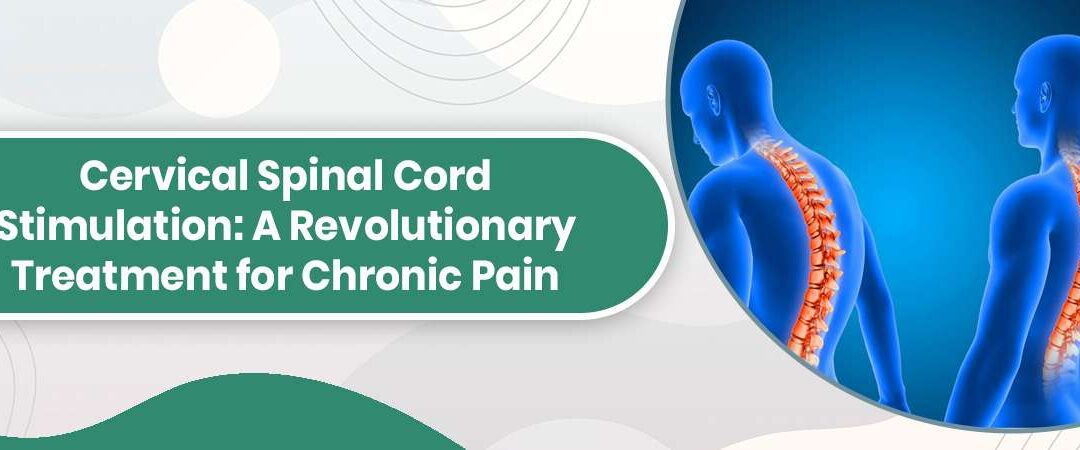The cervical spine, located in the neck, contains the spinal cord, which serves as a communication pathway between the brain and the rest of the body. When a person experiences chronic pain, such as that caused by conditions like cervical radiculopathy or failed neck surgery syndrome, the pain signals are transmitted through the spinal cord to the brain, where they are perceived as pain.

Chronic pain is a prevalent and debilitating condition affecting millions worldwide. Conventional treatments, such as medication and physical therapy, may relieve some extent, but innovative approaches are required for those with severe and persistent pain. One such ground-breaking method is cervical spinal cord stimulation (SCS).
Cervical SCS works by interrupting the transmission of pain signals from the cervical spine to the brain. For chronic pain patients, spinal cord stimulation can provide an alternative to medication or surgery.
Cervical spinal cord stimulation is a type of spinal cord stimulation that can help alleviate chronic pain in the neck, shoulders, and arms.

Choosing the right neurosurgeon is crucial for specialized medical procedures like cervical spinal cord stimulation.
Dr. Gurneet Singh Sawhney‘s reputation as one of the best neurosurgeon in Mumbai makes him an ideal choice for individuals seeking relief from chronic pain. His vast experience and extensive knowledge in neurosurgery, combined with his empathetic approach, ensure that patients receive exceptional care and the best possible outcomes.
Moreover, Dr. Gurneet Sawhney is a distinguished neuro and spine surgeon in Mumbai with over 15 years of experience. Known for his exceptional skills and expertise, patients trust him for spinal cord stimulation in Mumbai.
Dr. Gurneet Singh Sawhney’s passion for relieving patients suffering from chronic pain has driven him to excel in his profession. His commitment to staying at the forefront of medical advancements enables him to offer the most advanced and effective treatment options.
In this blog post, we will explore the concept of cervical SCS, its candidacy, procedure, associated costs, benefits and potential risks.
First, let’s understand,
What is Cervical Spinal Cord Stimulation, and How Does it Work?

This device delivers mild electrical pulses to the spinal cord, effectively altering the pain signals that travel to the brain. The electrical stimulation helps mask or replace the pain sensation, providing significant relief to patients suffering from chronic pain conditions.
Who is a Good Candidate for Cervical Spinal Cord Stimulation?
Usually, doctors recommend CSCS to individuals who meet the following criteria:
- Have chronic neck and arm pain resistant to conservative treatments, such as physical therapy, medication, and injections.
- Have undergone diagnostic procedures to identify the source of pain.
- Are motivated and committed to participating in the rehabilitation process.
- Do not have any medical conditions that would interfere with the procedure or device implantation.
Now, let’s know,
Cost of Cervical Spinal Cord Stimulation
The actual cost of CSCS can vary depending on several factors, including the healthcare facility, the surgeon’s expertise, the complexity of the case, and any additional services required. However, consulting with a healthcare provider or hospital administration for accurate cost estimates is essential.
Factors such as pre-operative tests, hospital stay, anesthesia, surgeon fees, and the device contribute to the overall expense. Despite potential costs, cervical spinal cord stimulation may be a cost-effective long-term solution for individuals who have exhausted other treatment options without success.
What to Expect During and After the Procedure?
The CSCS procedure involves several steps:
- Trial period: Before implantation, a temporary device is placed to evaluate its effectiveness in relieving pain. This trial period usually lasts for a few days.
- Implantation: If the trial is successful, the surgeon implants a permanent device under the skin. The procedure is typically performed under local anesthesia and may require a short hospital stay.

- Programming and adjustments: After the implantation, the device is programmed by a pain management specialist to deliver electrical impulses tailored to the patient’s pain pattern. Periodic adjustments may be needed to optimize pain relief.
- Recovery and rehabilitation: Doctors advise patients to rest and gradually resume their daily activities following the procedure. They may recommend physical therapy to enhance mobility and strength.
The doctor will provide specific instructions on post-procedure care, including activity restrictions and wound management. They may schedule regular follow-up visits to monitor the progress and adjust the stimulation settings.
Let’s look at the,
Benefits of Cervical Spinal Cord Stimulation
CSCS offers several significant benefits for chronic neck and arm pain patients. Some key advantages include:
- Effective pain relief: CSCS can alleviate pain unresponsive to conservative treatments, such as medication or physical therapy.
- Enhanced functionality: By reducing pain, CSCS enables patients to regain mobility and perform daily activities more efficiently.
- Reduced dependence on medication: For individuals reliant on pain medication, CSCS can help reduce or eliminate the need for long-term drug use, minimizing associated side effects and dependency risks.
- Reversible and adjustable: The stimulation parameters of the cervical stimulator can be adjusted or turned off if necessary, providing flexibility and control over pain management.
Risks and Side Effects of Cervical Spinal Cord Stimulation
While cervical spinal cord stimulation is generally considered safe, like any medical procedure, it carries some risks and potential side effects. These may include:
- Infection: There is a small risk of infection at the implantation site or within the spinal cord.
- Bleeding: Some patients may experience bleeding around the implantation site, although rare.
- Lead Displacement: The lead may shift from its original position, resulting in a loss of stimulation effectiveness.
- Device-related Issues: The pulse generator or lead may malfunction, requiring additional interventions or device replacement.
- Undesirable Sensations: Some patients may experience tingling, buzzing, or uncomfortable sensations at the stimulation site.
Cervical spinal cord stimulation offers hope for those with chronic neck and upper extremity pain. With Dr. Gurneet Singh Sawhney’s expertise as a highly-skilled neurosurgeon in Mumbai, individuals can find relief and regain control over their lives.
If you or your loved ones are struggling with chronic pain, consider exploring the possibilities of cervical SCS and consult with Dr. Sawhney to determine the best course of action.

